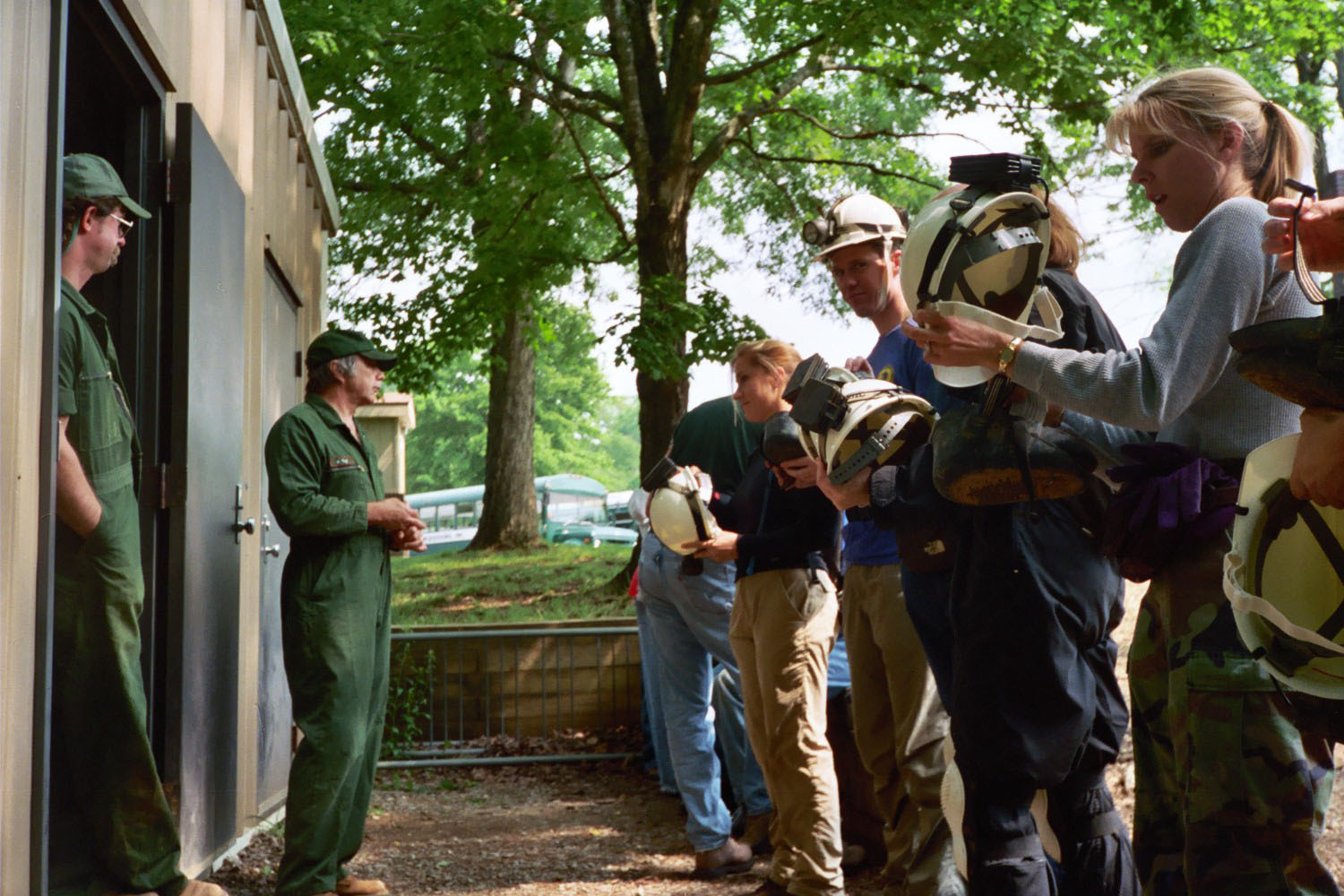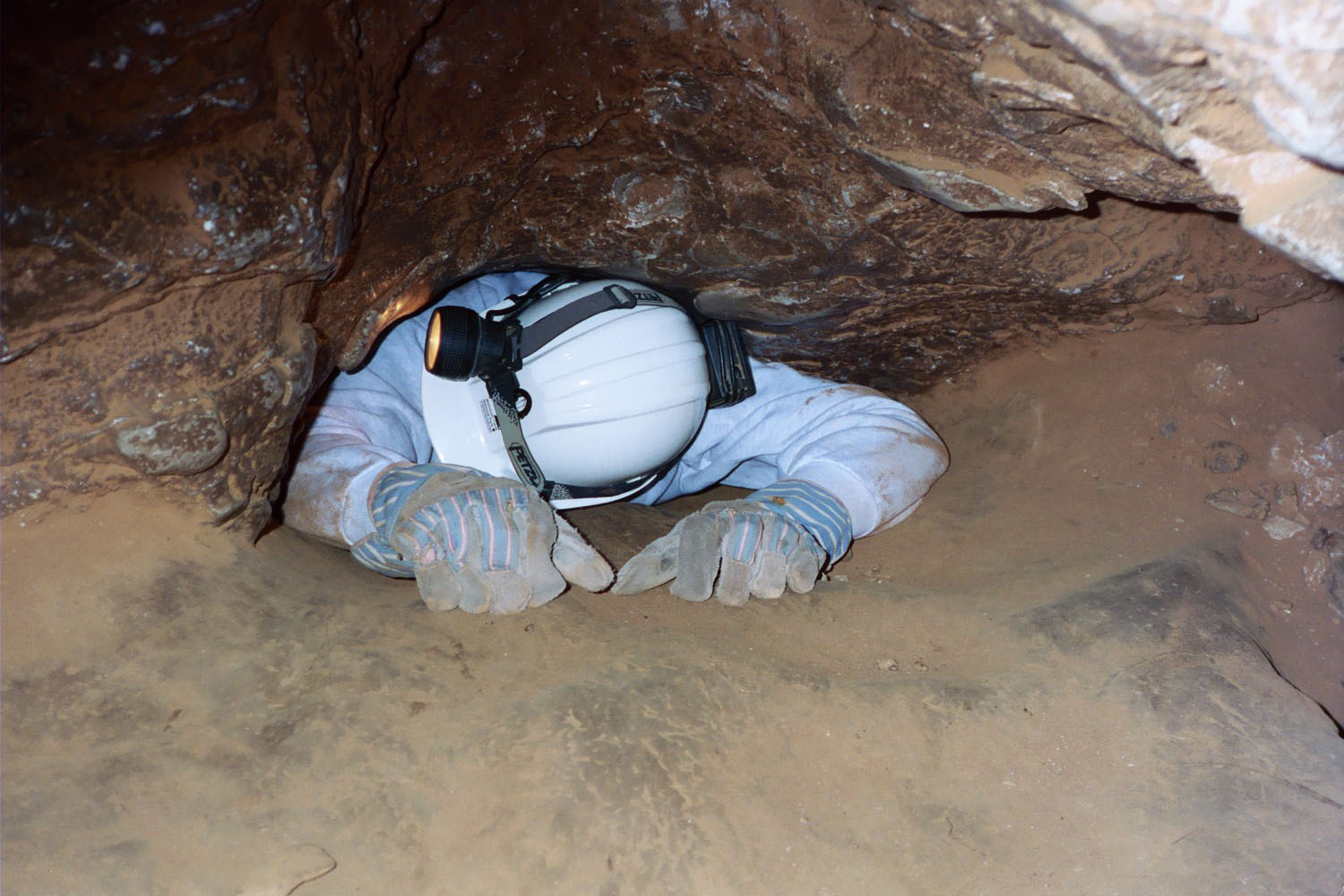
My helmet is stuck in the 9 x 12 inch “Barehole.”
I’m thinking that if I can’t get my head through, how can the rest of me make it? Called the Barehole because cavers shed shirts to twist through it, this introduction to claustrophobia is the ultimate challenge in Kentucky’s Mammoth Cave. My “Guardian Angel,” Don Locke, an attorney from Wisconsin, is on the other side of the hole advising me how to align my helmet. I shove him my fanny pack, thus removing an extra obstruction. I’m sweating in spite of the cool 54 degree temperature. My jeans and jersey are caked with red clay, but I’m determined to make the most of the “Wild Cave Tour.”
To get to this point, our band of fourteen neophyte knee-walkers, led by Park Rangers Keven Neff and Brice Leech, have crawled, duck-walked and climbed for nearly two hours reaching 300-foot depths below the earth’s surface—and we’re not even halfway through the tour. Neff waits patiently on the other side of the Barehole. With my head wedged sideways, I can’t see him, but I remember the cavers’ rule: no push, no pull.
“If someone gets stuck in a crawl,” says tour guide Chuck DeCroix, “we tell them to relax, blow out a little air and use teamwork to help them out. At no point do we pull or push someone deeper into a hole for fear of really getting them stuck. We offer support, but it’s up to them to get through on their own.”
Not exactly comforting words.

“You’re about to be tested,” says Neff, a retired schoolteacher who became a seasonal guide at Mammoth and then a year-round regular. “Getting through the Barehole is a mental thing. You have to believe you can do it. That hole is not for Arnold Schwarzenegger. Brute force won’t get you anything but stuck. Take your time, let out some air and make yourself fit.” The Wild Cave Tour offers 6 ½ hours and 5 ½ miles of hiking, crawling, climbing and squeezing through narrow passageways. In addition to crawling after park rangers, you get to see hard-to-reach places not available on regular walking tours. On the other side of the Barehole—if we ever get past it—the tour group will break for 30 minutes in the Snowball Room, a snack bar in a large room in the cave, and proceed to a new set of challenges. We’ll climb through canyons, walk on ledges and goggle at off-the-beaten-track sights such as Hovey’s Cathedral Domes, five connected domes averaging 100 feet high. Helmets, kneepads and lights are provided. High top boots that cover the ankle are required, with lug or deeply treaded soles; gloves and long pants are recommended. One’s chest size should not exceed 42 inches. There is a minimum age of 16 and a limit of 14 persons. The Wild Cave tour typically sells out months in advance.

Neff tells us “The Caving Rule of Four.“ Rule 4 – The minimum number of people to go caving with: four. If someone in your party were to be hurt, you could leave one person with the injured caver and two people could go for help. Rule 3 – Carry three independent light sources into a cave, especially lights that can be mounted on the helmet, whether electric lights, carbide lamps or flashlights. Most cavers also pack candles, matches, lighters, glow-sticks. Rule 2 – Tell two people where you’re going caving, specifically which part of the cave or which passageway you’re entering, and what time you’re coming out. If you’re not back two hours after when you said you would, surface watchers will assume you had a problem and will look for you. Rule 1 – If you are separated from your group or your light goes out or you don’t know where you are, stay in one place and wait. If you try to find the others, you could be going into different parts of the cave where they wouldn’t expect you to be and could make it harder for them to find you. Swallow your pride, remain where you are and wait to be found.

I inch forward, wondering if I should have opted for the less-challenging “Introduction to Caving” tour, which is half as long and doesn’t go off-trail as much. I’m 25 years older than most of my fellow cavers. Creeping and wriggling in front of and behind me are two chemical engineers (husband and wife), a pizza delivery guy, a UPS driver, an aerobics instructor so physically fit she laughs as she crawls, a retired firefighter, a nurse, two grad students, an optometrist and Don, angel attorney. We hail from Florida, Wyoming, Ohio, Minnesota, Wisconsin, Kentucky and Mississippi. After ten minutes of crawling through two-foot-high tunnels we are a cave family without secrets.
Teamwork is fundamental to caving. Each caver is responsible for the person behind him. Don continually checks on me, helmet light swinging around, flashing on the walls—“You doing okay?” Chris is last in line. Neff regularly calls over his shoulder, “Chris, are you there?” He tells us to turn off the lights on our helmets. One by one the lights are extinguished. The darkness is total and unforgiving. Like bats we extend our senses. It’s humbling and strangely exhilarating to be a rodent for thirty seconds. Neff tells us to be quiet and listen. The silence is deafening. “That’s what it’s like, down here, twenty-four hours a day,” he says.
Cavers will tell you that what keeps them going, no matter how formidable the environment, the bumps and bruises and scrapes, is not knowing what’s around the corner. “That’s what draws them into the cave,” says DeCroix, “and it’s what drew the Indians into the caves centuries ago. I think everybody has that curiosity, that sense of exploration in them.” Besides enjoying the natural wonders of Mammoth Cave, cavers are taught to conserve and protect it. “The hope is that in the future, the next generation will get to see the cave as we do.”
Respect it, says Neff. Leave it in as good condition as you found it —Don’t touch the sand covering that ledge. It’s been there a million years. Why brush it off? With every rock, every pebble, the cave is telling a primeval. Leave the cave pristine for others to enjoy. He points out holes in the cave wall where water dissolved softer minerals between the strata of the rocks. He shines his light on a sleeping bat (my motto: let sleeping bats cling) and on carbide burns where earlier cavers marked the rock ceiling with lamps.
A truly wild cave is one that hasn’t been fully explored and mapped. A group of graduate students and geologists from Western Kentucky University achieved something most cavers can only dream of. They discovered a large new cave, located in Wayne County, Ken., 50 miles southeast of Mammoth Cave. The main cave room was estimated to have a 90-foot ceiling and a floor space of 2.5 acres. [The largest room in Mammoth Cave, “Chief City,” is about 2 acres.] They also mapped a 4,000 foot path through the unnamed cavern, though much of its area remains unexplored.

Still, Mammoth Cave, with 350 miles of surveyed passageways, is three times longer than any known cave and it’s still being explored. Geologists estimate there could be as many as 600 miles of undiscovered passageways. Like most major caves, Mammoth Cave was formed by the slow dissolution of limestone by groundwater. Visitors have been crawling around in it since the War of 1812. To bolster our national image, Americans have long touted our “mammoth” wonders of nature: Mammoth Cave, Grand Canyon, Giant Sequoia. Mammoth Cave was designated a World Heritage Site in 1981 and became the core area of an International Biosphere Reserve in 1990. By any measure, Mammoth Cave is a national treasure and one of the wonders of the earth.
But knowing this won’t get me through the Barehole. If I can get my helmet through, maybe the rest of me will make it. “When you’re on the final hour of the Wild Cave tour,” says DeCroix, “crawling through a terrible, wet crawlway with pointy rocks poking at you, feeling wet, filthy, cold, and tired, and maybe you and the other cavers don’t smell very good—don’t forget, you’re having fun!”
Don advises me to stick both my arms through, above my head, then kick, paddle, wiggle and slither forward. “Five inches to go,” he says through the hole. I count down, “Five, four, three, two, one!” I pop out of the hole, gasping for breath, surprised to find fellow Wild Cavers waiting in the boulder-strewn delivery room. Keven Neff points at my white beard and announces, “It’s a boy.”
Larry Wells, who lives in Oxford, candidly admits he hasn’t been caving since he wrote this story. (“Down in a Hole” first appeared in Southwest Airlines’ Spirit Magazine.)

